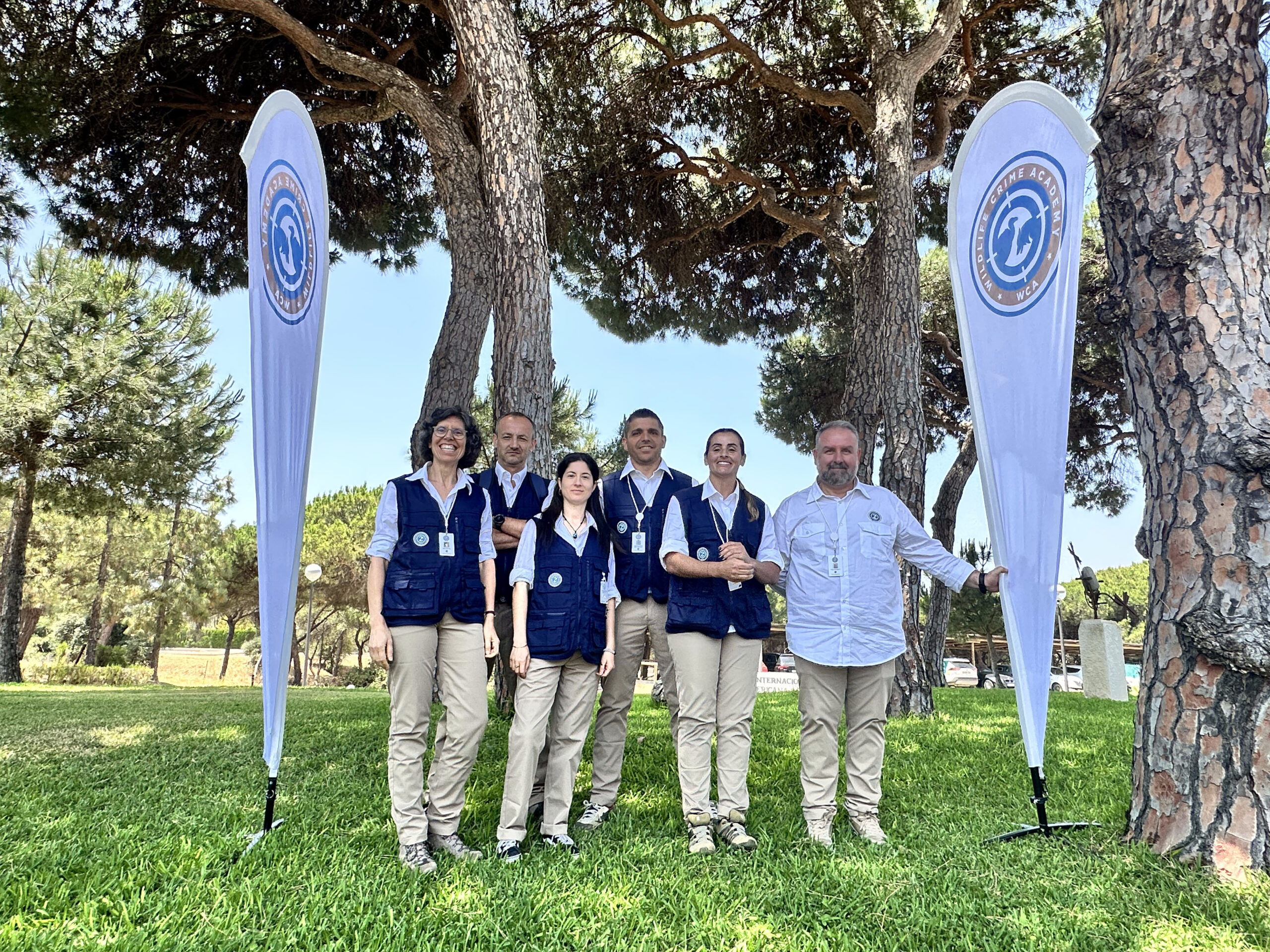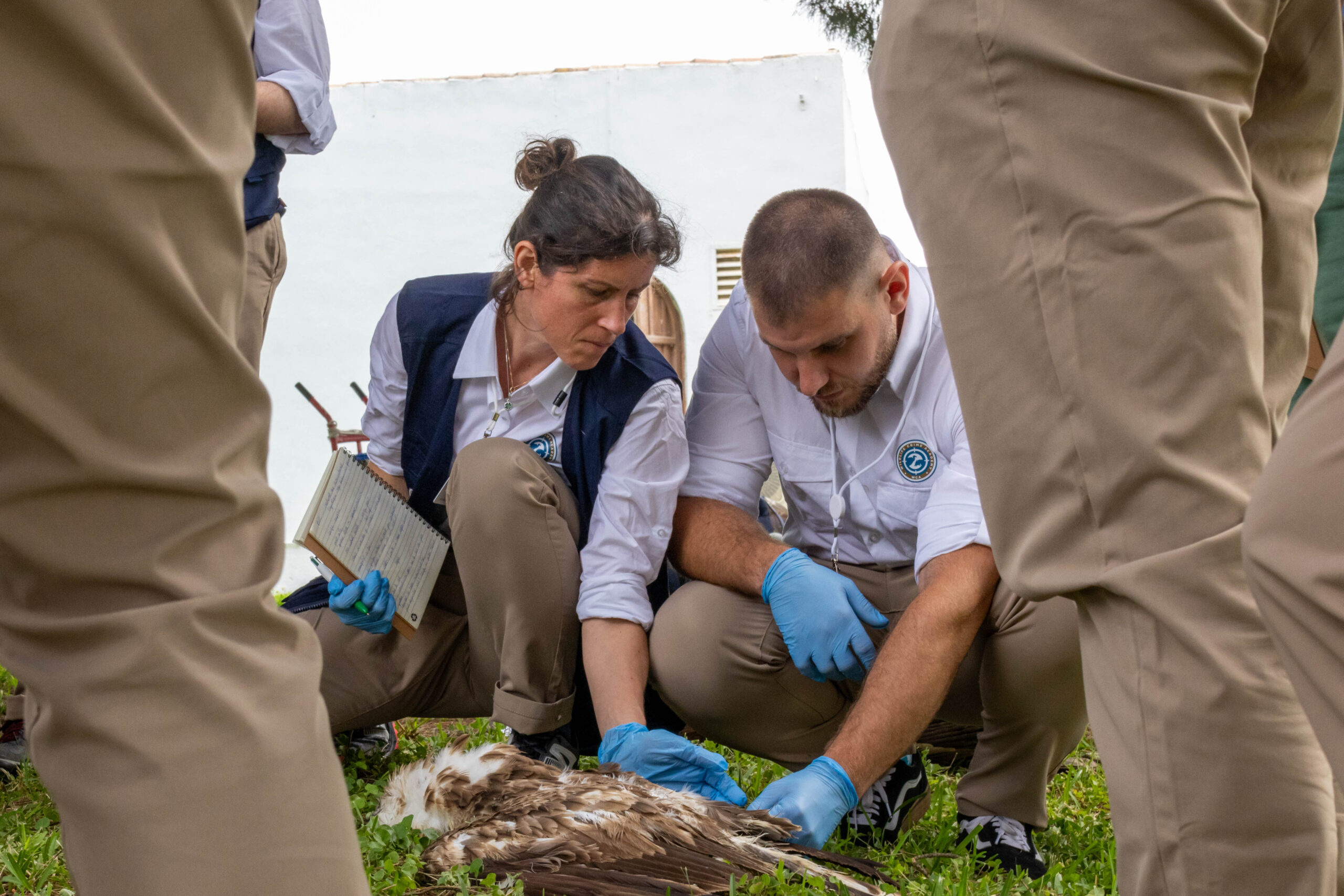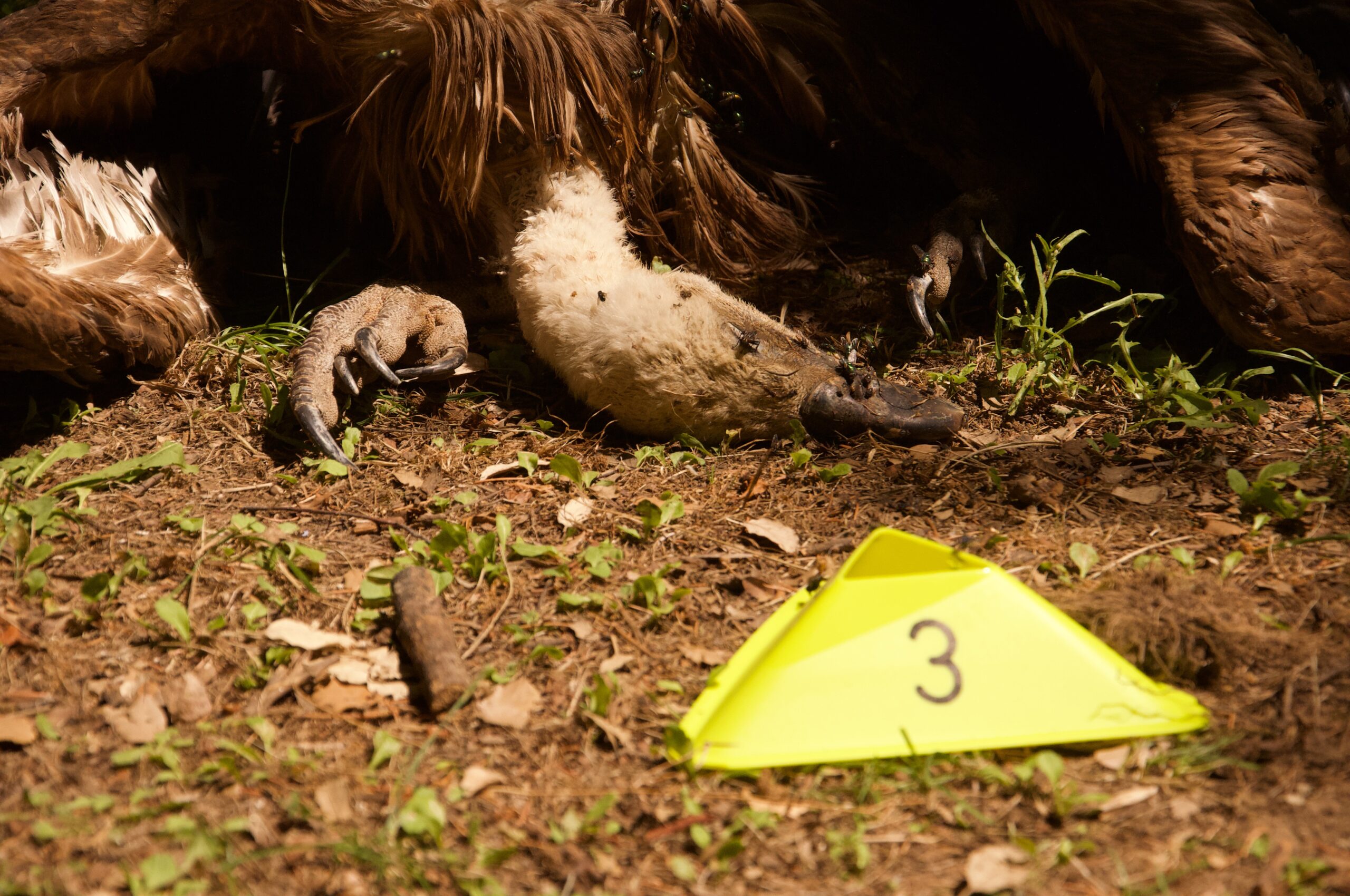Despite the serious consequences of wildlife poisoning for biodiversity and public health, impunity is almost total.
The use of poisons to kill wild or domestic animals, despite being a criminal offence punishable by a prison sentence, is still a relatively common practice in Portugal and around the world, which puts biodiversity, domestic animals and people at risk.

Poisoned baits © Silvio A. Rusmigo/ LIFE with Vultures
Poison: a problem with very serious consequences
Poisons are substances used illegally to control carnivorous predators such as wolves, foxes, genets, or stray dogs, especially in rural areas and in the context of hunting or farming activities. They are also frequently and intentionally used in situations of local conflicts (such as disputes between neighbours), or negligently in agriculture or forestry. However, as well as hitting the direct targets, the poisons also end up affecting other wild species that ingest the baits, and domestic animals – dogs, cats or livestock in extensive farming. Indirectly, poison affects species that feed on the corpses of poisoned animals, such as scavenging birds. In addition, poison can be accidentally ingested by people, particularly children, and contaminate soil and water, posing a serious threat to public health and the safety and well-being of human communities.
Some of the poisons used, such as strychnine, are highly toxic and deadly substances that have been banned in Portugal for many years, while others are phytopharmaceuticals or pesticides that can be easily acquired. Despite the serious dangers and existing legislation, the use of poisons remains a common practice in many countries, and Portugal is no exception.
Poisoning is one of the main threats to wildlife conservation, and has severe impacts, especially on species that are already at risk. Poisons can even cause the extinction of wild populations at a local or regional level, and impact entire ecosystems in devastating ways. Due to the type of food they eat and their behaviour, some animal groups are particularly vulnerable to poisoning, such as scavenging birds. In the case of vultures, poisoning is even the main cause of unnatural death globally.

Gutted calf, with poison in its belly, used as bait. ©Biom
LIFE Aegypius Return in the fight against poison
In Portugal, although the number of suspected poisoning cases has been falling in recent decades, the illegal use of poisons still represents a significant threat to wildlife, with more severe effects in the case of protected and endangered species. To help fight this problem, the LIFE Aegypius Return project – which focuses on the conservation of the Cinereous Vulture (Aegypius monachus) in Portugal and western Spain – promotes close cooperation with the Portuguese police Guarda Nacional Republicana (GNR) and its Nature and Environmental Protection Service (SEPNA), as well as with the Portuguese Antidote Programme (PAP), coordinated by the Institute for Nature Conservation and Forests (ICNF). The PAP is the official programme responsible for ensuring that all suspected cases of poisoning of endangered and priority species are formally investigated and that evidence is collected and analysed in accordance with the established chain of custody.
The LIFE Aegypius Return project also aims at enhancing GNR’s intervention capacities. Three new dogs are completing specialised training for poison detection, for later integration into the Cynotechnical Intervention Group (GIC). The GIC will soon be reinforced as two new poison detection teams will be based in Guarda, which will enable faster intervention in the centre and north of the country. The GNR also play a fundamental role in watching and reducing disturbance around the breeding colonies of the Cinereous Vulture. Since the beginning of the project in September 2022, the military have carried out approximately 200 preventive patrols in the areas covered, around a third of them with canine patrols. These preventive actions have had an important educational and deterrent value, with direct results on the tranquillity of the birds and, therefore, on their breeding success.

Preventive K9 Patrols with GNR Dog-Handler Teams. © GNR
In partnership with the Wildlife Crime Academy initiative, which was established through the BalkanDetox LIFE project, authorities and stakeholders from various countries are receiving training with best practice experience from Spain in combating wildlife crime. This training aims to improve their ability to manage and investigate wildlife poisoning and other environmental crimes. Portuguese stakeholders will also participate in this training. The ultimate goal is to equip these individuals with the necessary knowledge and tools to increase prosecutions, thereby deterring potential offenders from engaging in illegal and harmful activities against wildlife in the future.
Diagnosis of poisoning cases in Portugal
The LIFE Aegypius Return project recently published a report analysing the data on suspected poisoning cases recorded by the GNR/SEPNA since 2021, also comparing it with previous data (from 2013 to 2018) compiled under the LIFE Imperial project, which focused on the conservation of the Iberian Imperial Eagle (Aquila adalberti), a Critically Endangered species. The report also presents two case studies, to better illustrate the dynamics and limitations inherent in detecting and investigating suspected cases.
The data compiled shows that from January 2013 to June 2024, the GNR/SEPNA recorded 225 suspected cases of poisoning, which affected 385 domestic and wild terrestrial animals. During this period, significant numbers of protected and endangered species were impacted, including the Red kite (Milvus milvus, 71 individuals), the Iberian imperial eagle (16 individuals), the Cinereous Vulture (9 individuals) and the Iberian wolf (Canis lupus signatus, 3 individuals).
Analysing only the most recent set of data, recorded by the GNR/SEPNA since January 2021, 84 cases of suspected poisoning were recorded in mainland Portugal, an average of two cases per month. These cases resulted in the death of a total of 131 terrestrial animals. The potentially poisoned animals belonged to 17 species, with 53% (n=70) domestic animals (dogs, cats, birds and a sheep) and 47% (n=61) wild animals. The most affected wild species were the red kite (21 dead individuals), whose breeding populations are Critically Endangered; the Red fox (Vulpes vulpes, 13 individuals); the Griffon Vulture (Gyps fulvus, 6 individuals); the White stork (Ciconia ciconia, 6 individuals); the Iberian imperial eagle (5 individuals); and the Cinereous Vulture (2 individuals), an Endangered species.


Detection of a dead cinereous vulture with symptoms of poisoning and collection of the corpse by the authorities, in accordance with the protocol of the Antidote Programme. ©ATN/Faia Brava
In each period analysed, the geographical distribution of registered cases varies, however, the districts of Beja, Castelo Branco and Bragança seem to maintain a certain consistency in the highest number of cases.
In general, in recent years there seems to be a slight decrease in the number of suspected cases, as well as in the number of affected animals, but the data fluctuates between different years, and it is too early to draw conclusions.
Whenever possible, during the investigation of these suspected cases, samples are taken, such as any baits or corpses detected, as well as soil or other potentially contaminated materials. Samples are then sent for analysis to reference laboratories. In the GNR database, the use of poisons is only confirmed in 9 of the 84 cases recorded since 2021 (c. 11%). These cases caused the death of 12 animals: three kites, three foxes, one Griffon Vulture, as well as four dogs and one domestic cat.

Location of suspected (n=75; blue dots) and confirmed (n=9; red dots) poisoning cases recorded by the GNR/SEPNA in mainland Portugal between 01/01/2021 and 30/06/2024. SPA – Special Protection Areas (Natura 2000 Network). CV – Cinereous vulture. © LIFE Aegypius Return
A legal system with many constraints
The technical limitations of the official Portuguese laboratories in detecting the presence of poisons in samples taken in the field is one of the major restrictions on the full application of the PAP and the investigation of cases. Sometimes, counter-analyses carried out on the same samples, at the request of environmental non-governmental organisations (NGO) in other laboratories with more modern equipment and more sensitive to lower dosages, have revealed positive results. However, since these results do not fall within the official chain of custody they have no legal validity in the formal investigation of cases, which end up being filed on the basis of false negatives.
Another constraint is that the formal PAP protocol is not always fully applied at all stages of the process, whether due to limited human and technical resources, the inability of all the parties involved to respond immediately, or time-consuming bureaucratic obstructions that don’t match the need for urgent action in such cases.
The data presented is certainly underestimated, since many cases may not have been detected, or may have entered the legal records through the PAP, wildlife recovery centres or other authorities. There is no integrated, continuously updated database that allows the authorities to cross-check information quickly and effectively. Similarly, the entity reporting the cases does not always receive feedback on the conclusion of the investigation, leaving the respective database incomplete. These gaps in the reporting and management of cases make it difficult to conduct a thorough and more accurate analysis of the situation regarding the use of poisons in Portugal, which may contribute to the underestimation of the problem.
Finally, the final decision on cases depends on the assessment of prosecutors and judges who have varying degrees of sensitivity to environmental crime. In a system where resources are scarce, wildlife crimes are often not prioritized and are dismissed due to the failure to identify suspects and the lack of evidence after a basic investigation.
In Portugal, there are almost no convictions in cases of wildlife poisoning, which perpetuates a certain feeling of impunity, given the complexity in identifying suspects. Although, in general, there has been greater attention paid to wildlife crime and an intensification of efforts to curb and combat these illegal practices, both public perception and the legal system are still far from what is needed and desired. For this reason, several conservation projects, such as LIFE Aegypius Return, collaborate with the competent authorities to identify and remedy shortcomings, follow the investigation of cases, discuss solutions that increase the effectiveness of procedures at all stages, and thus counter impunity and strengthen the fight against poisons.


Sample collection and identification of evidence by GNR/SEPNA in a case of suspected poisoning. © Sentinelas / Palombar
How can you help in the fight against the use of poisons?
Any citizen can help in the fight against poison. The fight against these crimes requires action from everyone, not just the authorities or conservationists. The most important step is to be informed, vigilant and report all cases of wildlife crime. So, if you spot any suspicious cases, contact the authorities immediately! In Portugal, use the SOS Environment and Territory Line: 808 200 520, and provide as much information as possible. Never touch corpses, bait or potentially contaminated material, or allow anyone to interfere with a possible crime scene until the authorities arrive.
LIFE Aegypius Return

The LIFE Aegypius Return project is co-financed by the European Union’s LIFE programme. Its success depends on the involvement of all the relevant stakeholders, and the collaboration of the partners, the Vulture Conservation Foundation (VCF), the coordinating beneficiary, and the local partners Palombar – Conservação da Natureza e do Património Rural, Herdade da Contenda, Sociedade Portuguesa para o Estudo das Aves, Liga para a Protecção da Natureza, Associação Transumância e Natureza, Fundación Naturaleza y Hombre, Guarda Nacional Republicana and Associação Nacional de Proprietários Rurais Gestão Cinegética e Biodiversidade.




